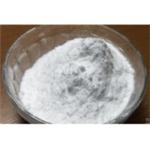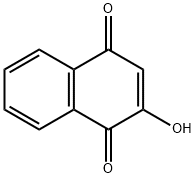2-Hydroxy-1,4-naphoquinone
- CAS No.
- 83-72-7
- Chemical Name:
- 2-Hydroxy-1,4-naphoquinone
- Synonyms
- LAWSONE;2-Hydroxynaphthalene-1,4-dione;2-HYDROXY-1,4-NAPHTHOQUINONE;Lawson;Henna;2-Hydroxynaphthoquinone;3-Hydroxy-1,4-naphthoquinone;Hana;Mendi;Mehendi
- CBNumber:
- CB2493073
- Molecular Formula:
- C10H6O3
- Molecular Weight:
- 174.15
- MDL Number:
- MFCD00001678
- MOL File:
- 83-72-7.mol
- MSDS File:
- SDS
| Melting point | 192-195 °C (dec.)(lit.) |
|---|---|
| Boiling point | 265.11°C (rough estimate) |
| Density | 1.2346 (rough estimate) |
| refractive index | 1.5036 (estimate) |
| storage temp. | Sealed in dry,Room Temperature |
| solubility | Acetonitrile (Slightly), Chloroform (Slightly), Methanol (Slightly) |
| pka | 4.31±0.10(Predicted) |
| Colour Index | 75480 |
| form | Crystalline Powder |
| color | Yellow |
| Water Solubility | 2 g/L (20 ºC) |
| Merck | 14,5393 |
| BRN | 1565260 |
| Stability | Stable. Combustible. Incompatible with strong oxidizing agents. |
| InChIKey | CSFWPUWCSPOLJW-UHFFFAOYSA-N |
| LogP | 1.380 |
| CAS DataBase Reference | 83-72-7(CAS DataBase Reference) |
| FDA 21 CFR | 73.2190 |
| EWG's Food Scores | 1-6 |
| FDA UNII | TLH4A6LV1W |
| NIST Chemistry Reference | 1,4-Naphthalenedione, 2-hydroxy-(83-72-7) |
| EPA Substance Registry System | 2-Hydroxy-1,4-naphthoquinone (83-72-7) |
SAFETY
Risk and Safety Statements
| Symbol(GHS) |  GHS07 |
|||||||||
|---|---|---|---|---|---|---|---|---|---|---|
| Signal word | Warning | |||||||||
| Hazard statements | H315-H319-H335 | |||||||||
| Precautionary statements | P261-P264-P271-P280-P302+P352-P305+P351+P338 | |||||||||
| Hazard Codes | Xi,Xn | |||||||||
| Risk Statements | 36/37/38-68-36-22 | |||||||||
| Safety Statements | 26-37/39-36/37/39-36 | |||||||||
| WGK Germany | 3 | |||||||||
| RTECS | QL8200000 | |||||||||
| TSCA | Yes | |||||||||
| HS Code | 29146990 | |||||||||
| NFPA 704 |
|
2-Hydroxy-1,4-naphoquinone price More Price(23)
| Manufacturer | Product number | Product description | CAS number | Packaging | Price | Updated | Buy |
|---|---|---|---|---|---|---|---|
| Sigma-Aldrich | H46805 | 2-Hydroxy-1,4-naphthoquinone 97% | 83-72-7 | 10g | $39.7 | 2024-03-01 | Buy |
| Sigma-Aldrich | H46805 | 2-Hydroxy-1,4-naphthoquinone 97% | 83-72-7 | 25g | $66.1 | 2024-03-01 | Buy |
| TCI Chemical | H0285 | 2-Hydroxy-1,4-naphthoquinone >98.0%(T) | 83-72-7 | 25g | $41 | 2024-03-01 | Buy |
| TCI Chemical | H0285 | 2-Hydroxy-1,4-naphthoquinone >98.0%(T) | 83-72-7 | 100g | $112 | 2024-03-01 | Buy |
| Alfa Aesar | A11880 | 2-Hydroxy-1,4-naphthoquinone, 98+% | 83-72-7 | 10g | $25.5 | 2024-03-01 | Buy |
2-Hydroxy-1,4-naphoquinone Chemical Properties,Uses,Production
Description
Lawsone [CAS: 83-72-7] (CI Natural Orange 6; CI 75420), also known as henna and isojuglone, occurs in the shrub henna (Lawsone alba). In England, the plant is known as Egyptian privet. The dye was extracted from the leaves of the plant, using sodium bicarbonate, and the extracts used to dye protein fibers an orange shade. Henna is probably the oldest cosmetic known. The ancient Egyptians used it as a hair dye and for staining fingernails. It is said that Mohammed dyed his beard with henna. Lawsone has been identified as 2-hydroxy-1,4-naphthoquinone. It has been synthesized by the Thiele acetylation of 1,4-naphthoquinone followed by hydrolysis and oxidation.
Chemical Propterties
2-Hydroxy-1,4-naphthoquinone (HNQ, C10H6O3) is also called Lawsone, which is a white cubic crystal. Its melting point is 192-195 oC, and flash point is 192 oC. The solubility of HNQ is 2 g/L in water at 20 oC. It is stable, but it is combustible and incompatible with strong oxidizing agents.
Application
2-Hydroxy-1,4-naphthoquinone(HNQ) is the principal natural dye ingredient contained at 1.0-1.4% in the leaves of Henna (Lawsonia inermis). It is an ancient red-orange dye. Henna has been used for more than 4000 years not only as a hair dye, but also as a body paint and tattoo dye. Today, semi-permanent hair dyes containing Henna as well as its pure dye ingredient HNQ are widely used and have become increasingly popular due to their natural origin.
Biological Toxicity
2-Hydroxy-1,4-naphoquinone(HNQ) was reported to be a weak bacterial mutagen for Salmonella typhimurium strain TA98 or was more clearly mutagenic for strain TA 2637, both in the presence of metabolic activation. HNQ was unable to induce sex-linked recessive lethal mutations in Drosophila melanogaster. The available data suggest that the use of Henna or 2-Hydroxy-1,4-naphoquinone(HNQ) for hair dyeing presents no or negligible risk of genotoxicity to the consumer.
Chemical Properties
Yellow crystal powder
History
Lawsone (CI Natural Orange 6; CI 75420), also known as henna and isojuglone, occurs in the shrub henna (Lawsone alba). In England, the plant is known as Egyptian privet. The dye was extracted from the leaves of the plant, using sodium bicarbonate, and the extracts used to dye protein fibers an orange shade. Henna is probably the oldest cosmetic known. The ancient Egyptians used it as a hair dye and for staining fingernails. It is said that Mohammed dyed his beard with henna. Lawsone has been identified as 2-hydroxy-1,4-naphthoquinone. It has been synthesized by the Thiele acetylation of 1,4-naphthoquinone followed by hydrolysis and oxidation.
Uses
An antimicrobial antioxidant dye isolated from Henna.
Uses
antifungal, sunscreen, antibacterial, antineoplastic
Uses
2-Hydroxy-1,4-naphthoquinone is used for preparing decorative hair and skin dyes. 2-Hydroxy-1,4-naphthoquinone also demonstrates antimicrobial and antioxidant effects. It also suppress the formation of hydrogen peroxide and superoxide radical anion by aldehyde oxidase-catalyzed reactions.
Definition
A coloring principle obtained from dried leaves of certain tropical plants (North Africa, India).
Synthesis Reference(s)
The Journal of Organic Chemistry, 53, p. 808, 1988 DOI: 10.1021/jo00239a023
Tetrahedron Letters, 25, p. 533, 1984 DOI: 10.1016/S0040-4039(00)99930-1
General Description
Yellow prisms or yellow powder.
Air & Water Reactions
Insoluble in water.
Reactivity Profile
Phenols, such as 2-Hydroxy-1,4-naphoquinone, do not behave as organic alcohols, as one might guess from the presence of a hydroxyl (-OH) group in their structure. Instead, they react as weak organic acids. Phenols and cresols are much weaker as acids than common carboxylic acids (phenol has Ka = 1.3 x 10^[-10]). These materials are incompatible with strong reducing substances such as hydrides, nitrides, alkali metals, and sulfides. Flammable gas (H2) is often generated, and the heat of the reaction may ignite the gas. Heat is also generated by the acid-base reaction between phenols and bases. Such heating may initiate polymerization of the organic compound. Phenols are sulfonated very readily (for example, by concentrated sulfuric acid at room temperature). The reactions generate heat. Phenols are also nitrated very rapidly, even by dilute nitric acid. Nitrated phenols often explode when heated. Many of them form metal salts that tend toward detonation by rather mild shock.
Health Hazard
ACUTE/CHRONIC HAZARDS: 2-Hydroxy-1,4-naphoquinone may be absorbed through the skin and can cause skin irritation.
Fire Hazard
Flash point data for 2-Hydroxy-1,4-naphoquinone are not available but 2-Hydroxy-1,4-naphoquinone is probably combustible.
Contact allergens
Henna, prepared by powdering the dried leaves of henna plant (Lawsonia inermis L.), is used for coloring and conditioning hair and nails, particularly by Muslims or Hindus. It contains Lawsone, which very rarely induces contact allergy. Most dermatitis caused by “black henna” is due to PPD and derivatives
Purification Methods
Crystallise Lawsone B from *C6H6 or AcOH (m 192.5o, 195-196o). It sublimes in a vacuum (m 194o). It has UV with max at 455nm (aqueous NaOH). [Beilstein 8 H 300, 8 I 635, 8 II 344, 8 III 2543, 8 IV 2360.]
2-Hydroxy-1,4-naphoquinone Preparation Products And Raw materials
Raw materials
1of4
Preparation Products
| Supplier | Tel | Country | ProdList | Advantage | |
|---|---|---|---|---|---|
| Hebei Mojin Biotechnology Co., Ltd | +86 13288715578 +8613288715578 | sales@hbmojin.com | China | 12840 | 58 |
| Hebei Chuanghai Biotechnology Co,.LTD | +86-13131129325 | sales1@chuanghaibio.com | China | 5893 | 58 |
| Henan Bao Enluo International TradeCo.,LTD | +86-17331933971 +86-17331933971 | deasea125996@gmail.com | China | 2472 | 58 |
| Henan Tianfu Chemical Co.,Ltd. | +86-0371-55170693 +86-19937530512 | info@tianfuchem.com | China | 21634 | 55 |
| Shanghai Zheyan Biotech Co., Ltd. | 18017610038 | zheyansh@163.com | CHINA | 3619 | 58 |
| career henan chemical co | +86-0371-86658258 +8613203830695 | sales@coreychem.com | China | 29884 | 58 |
| SHANDONG ZHI SHANG CHEMICAL CO.LTD | +86 18953170293 | sales@sdzschem.com | China | 2930 | 58 |
| Jinan Carbotang Biotech Co.,Ltd. | +8615866703830 | figo.gao@foxmail.com | China | 8497 | 58 |
| Chengdu Biopurify Phytochemicals Ltd. | +8618080483897 | sales@biopurify.com | China | 3772 | 58 |
| Hubei Jusheng Technology Co.,Ltd. | 18871490254 | linda@hubeijusheng.com | CHINA | 28172 | 58 |
Related articles
- What is 2-Hydroxy-1,4-naphoquinone?
- 2-Hydroxy-1,4-naphthoquinone (HNQ, C10H6O3, CAS registry No. 83-72-7) is also called Lawsone, which is a white cubic crystal.
- Feb 14,2020
View Lastest Price from 2-Hydroxy-1,4-naphoquinone manufacturers
| Image | Update time | Product | Price | Min. Order | Purity | Supply Ability | Manufacturer | |
|---|---|---|---|---|---|---|---|---|
 |
2024-11-21 | 2-Hydroxy-1,4-naphoquinone
83-72-7
|
US $5.00 / kg | 1kg | ≥98% | 200mt/year | Jinan Finer Chemical Co., Ltd | |
 |
2024-11-19 | Lawsone
83-72-7
|
US $45.00 / mg | 99.58% | 10g | TargetMol Chemicals Inc. | ||
 |
2024-11-14 | 2-Hydroxy-1,4-naphoquinone
83-72-7
|
US $403.00 / KG | 1KG | 99% | 10t | Baoji Guokang Bio-Technology Co., Ltd. |
-

- 2-Hydroxy-1,4-naphoquinone
83-72-7
- US $5.00 / kg
- ≥98%
- Jinan Finer Chemical Co., Ltd
-

- Lawsone
83-72-7
- US $45.00 / mg
- 99.58%
- TargetMol Chemicals Inc.
-

- 2-Hydroxy-1,4-naphoquinone
83-72-7
- US $403.00 / KG
- 99%
- Baoji Guokang Bio-Technology Co., Ltd.





